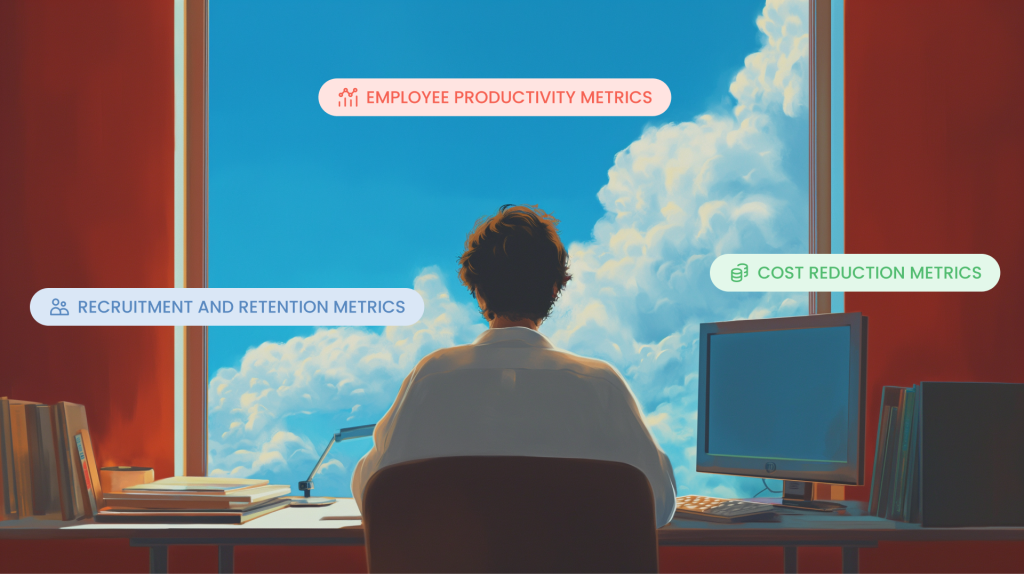In the business context, Return on Investment (ROI) is arguably one of the more important metrics. Think about it—for any organization to maintain their success, the money spent needs to at least be returned (and for most organizations, a profit on top). ROI might be relatively easy to track in certain departments (like Sales), but this becomes a bit trickier when it comes to Human Resources, particularly with technology investments.
Human Resources Information Systems (HRIS) are platforms that automate, streamline, and centralize many HR administrative and performance management tasks. While they often require a substantial upfront investment, many HR professionals are discovering immense value in their HRIS, resulting in a favorable HRIS ROI.
Here’s what you need to consider as you look to invest in HR Software and demonstrate its value:
What is Return on Investment (ROI)?
ROI is one of the most crucial metrics for businesses to track, acting as a yardstick that measures the profitability of investments made by the business. For Human Resources and HR software, understanding ROI is particularly important, as your organization looks to optimize its workforce management and efficiency.
Defining ROI: Unpacking the basics
At its core, ROI is a straightforward concept. It refers to the ratio of the net gain from an investment relative to its cost. Expressed as a percentage, ROI helps organizations evaluate the success of a particular venture, project or expenditure. Simply put, the higher the ROI, the more profitable the investment.
How ROI Applies to Human Resources
For HR purposes, investing in HRIS is an intelligent move for organizations looking to take their HR practices to the next level. Implementing HRIS not only modernizes outdated processes but can contribute significantly to overall cost savings and productivity gains. Whether it’s automating routine tasks or providing data-driven insights, HRIS can be a major boost to efficiency and accuracy.
Learn more: Your Guide to Choosing the Right HR Software for Small Business
Why Measure HRIS ROI?

The decision to adopt an HRIS goes beyond a quick tech upgrade; it represents a strategic decision requiring meticulous consideration of metrics like HRIS ROI to confirm that the investment aligns with the organization’s objectives.
1. Quantifying tangible benefits
Measuring HRIS ROI allows your business to pinpoint the actual impact on productivity, time savings, and cost reductions. It could be streamlining recruitment processes or automating employee onboarding, but HRIS has real, measurable outcomes that contribute to your bottom line.
2. Aligning HR strategy with organizational goals
Measuring HRIS ROI ensures that HR initiatives align with broader organizational goals. Whether the focus is on talent acquisition, retention, or workforce analytics, a clear understanding of ROI ensures that your HR efforts contribute to the overall success of the business. Even if you know your investments are paying off, tracking and documenting them will help both optimize them further, and demonstrate your contributions to decision-makers.
3. Justifying investments and building business cases
The nature of business means investments need to be justified. Measuring HRIS ROI equips HR professionals with the tools to build compelling business cases. If you are seeking budget approval or advocating for technology adoption, a solid ROI analysis will show the value of your investment in HRIS.
4. Continuous improvement
HRIS is not a singular solution; rather, it is a dynamic system that evolves alongside the organization’s growth. Measuring HRIS ROI establishes a feedback loop for continuous improvement. By analyzing the impact of HRIS over time, your organization can identify areas for improvement or adjustments, ensuring that the system continually adds value and adapts to your organization’s changing business needs.
5. Enhancing decision-making with data-driven insights
HRIS is a treasure trove of data, and measuring ROI realizes the power of this information. By analyzing the data generated by the system, organizations gain valuable insights into employee performance, employee engagement, and overall workforce trends. Informed decision-making becomes a reality when HR professionals can leverage these data-driven insights to drive organizational strategies and engagement.
6. Demonstrating HR’s strategic impact
Assessing HRIS ROI transforms the role of HR, shifting it from the stereotype of handling basic administrative functions to becoming a valuable strategic partner in your organization’s success. It showcases HR’s ability to make data-driven decisions, contribute to cost savings, and drive efficiency. Highlighting the strategic influence of HRIS to position your HR team as a crucial partner in achieving your organization’s goals.
What to Include When Calculating HRIS ROI?
Calculating your HRIS ROI requires taking a closer look at the many different factors that define each HRIS, and how they impact your organization specifically.
Implementation costs
Begin by accounting for the initial costs associated with implementing HRIS. This includes software licensing fees, customization expenses, and costs related to data migration and integration with your existing systems. A clear and accurate view of the implementation costs provides a baseline for understanding the investment required upfront. If the cost is high, the return is going to need to be even higher to justify it.
Training and change management
Think about the expenses related to training your workforce on the new HRIS and implementing change management programs. A well-trained team ensures that everyone is making the most out of the system, maximizing its potential benefits (and return). Training costs, sometimes overlooked, play a pivotal role in achieving a smooth transition and realizing long-term value.
Maintenance and support
Factor in ongoing maintenance and support costs for the HRIS. This includes fees for software updates, technical support, and any necessary troubleshooting. A reliable support infrastructure is important for ensuring that your HRIS runs smoothly and consistently, avoiding potential disruptions on your daily HR operations.
Improved accuracy and compliance
Consider the favorable impacts of HRIS on data accuracy and compliance. Reduced errors in payroll processing, enhanced data security, and keeping up with regulatory requirements collectively contribute to minimizing the overall risk of errors. Similarly, when measuring HRIS ROI, it is important to account for the avoidance of fines and penalties associated with compliance resulting from the adoption of HRIS.
Recruitment and onboarding efficiency
When projecting your HRIS ROI, account for your efficiency gains in recruitment and onboarding processes augmented by your HRIS. Factors such as reduced time-to-hire, improved candidate experience, and streamlined employee onboarding workflows lead to cost savings and allow your organization to scale faster.
Future proofing your investment
Last but not least, assess the scalability of your HRIS. A system that can grow with your organization minimizes the need for costly upgrades or replacements in the future. Scalability contributes to long-term HRIS ROI by ensuring that your HRIS still offers value, even as your organization needs evolve.
HR Metrics to Assess ROI

When evaluating HRIS ROI, specific HR metrics need to be considered to provide a nuanced understanding of the system’s impact on your organization:
Employee Productivity Metrics
- Time saved on administrative tasks: Measure the reduction in time spent on routine HR tasks, such as payroll processing, benefits administration, and time tracking. A decrease in manual workload directly contributes to improved employee productivity.
- Employee engagement and performance: Use surveys and performance metrics to gauge changes in employee engagement and performance. A well-implemented HRIS should correlate with higher engagement levels and improved individual and team performance.
Recruitment and Retention Metrics
- Time-to-hire: Evaluate how quickly your organization is able to fill open positions. A drop in time-to-hire shows efficiency is improving in the recruitment process, in turn reducing the cost of the process.
- Turnover rates: Look for changes in your employee turnover rates. A successful HRIS implementation should positively impact retention by improving employee satisfaction and engagement.
- Quality of hire: Assess the quality of new hires by tracking their performance and contributions, especially in the months after they’ve joined your team. A rise in quality and fit of hires should indicate your HRIS is allowing for better candidate sourcing.
Cost Reduction Metrics
- Reduction in administrative costs: Calculate the reduction in costs associated with manual HR processes. This includes savings on paper, printing, and other administrative expenses that are reduced by automation.
- Compliance-related savings: Assess the financial impact of improved compliance through reduced errors and streamlined processes. Avoiding fines and penalties contributes directly to HRIS ROI.
- Training and onboarding costs: Compare pre and post-HRIS implementation training and onboarding costs. A successful HRIS should lead to efficiencies in these processes, resulting in reduced training expenses over time.
Improving ROI with HRIS Data
Unlocking the full potential of your HRIS ROI goes beyond implementation—it’s about leveraging HRIS data over time to enhance decision-making, foster continuous improvement, and engage in proactive problem-solving. Here’s how you can optimize your HRIS investment by harnessing the power of data:
Data-Driven Decision Making
- Workforce analytics: Use your HRIS data to gain accurate insights into workforce trends, performance metrics, and talent acquisition. Data-driven decision-making empowers your HR team to align their strategies with organizational goals, meaning your initiatives are optimized to impact your organization’s bottom line.
- Predictive analytics: Leverage predictive analytics within your HRIS to forecast future workforce needs, identify potential talent gaps, and proactively address issues before they impact your organization. This strategic approach minimizes reactionary measures, unnecessary change and contributes to long-term ROI.
- Performance metrics: Assess employee performance using data gathered from the HRIS. Identify high-performing employees and teams, recognize areas for improvement, and align training and development programs with your organizations needs.
Continuous Improvement
- Regular data audits: Conduct regular audits of HRIS data to ensure accuracy and relevance as it relates to the high-level goals of your organization. Continuous improvement relies on reliable data. Identify and fix any tracking errors promptly to make sure you’re getting the most from your HRIS.
- Benchmarking against key metrics: Set benchmarks based on defined HR metrics and regularly compare actual performance against these benchmarks. This enables you to identify areas for improvement, measure progress over time, and ensure that the HRIS ROI continues to be tracked.
Proactive Problem Solving
- Identifying trends and patterns: Use HRIS data to identify trends and patterns within your workforce. You can proactively address issues related to employee satisfaction, engagement, and performance before they become a problem.
- Employee feedback analysis: Leverage HRIS tools that collect and analyze employee feedback. Identify common concerns, feelings, and areas of improvement. Proactively addressing your employee concerns contributes to a positive workplace culture and can impact retention rates, a major factor to consider when measuring HRIS ROI.
- Scenario planning: HRIS data is important for scenario planning. Anticipate changes in workforce dynamics, such as shifts in demographics or skill requirements, and update your strategy accordingly. Proactive scenario planning helps your organization to stay ahead of industry trends and adapt to evolving challenges.
Maximize Your HRIS ROI with Omni’s All-in-One HR Tool
By embracing technologies such as applicant tracking systems, HRIS, and employee management HR tools, HR professionals can enhance their processes, improve outcomes, and create a competitive advantage for their organizations, enhancing efficiency, accuracy, and employee experience within their organizations.
Modern HR automation tools like Omni free HR teams from administrative cycles by automating the entire end-to-end employee lifecycle—from recruitment and onboarding to employee engagement and payroll—allowing HR to redirect their time to strategic work that drives business growth.
With Omni, you gain access to data-driven insights that empower informed decision-making, as well as seamless integrations that effortlessly connect with your existing employee favored systems, making your entire engagement process more efficient and modern.
Omni scales alongside your team so you can customize and leverage the system to meet your business exactly where you are—as well as where you’re going.
If you’d like to learn more about how Omni’s all-in-one HR software automates the entire end-to-end employee lifecycle, saving People leaders from administrative tasks and increasing organizational innovation, book a demo with our team!


